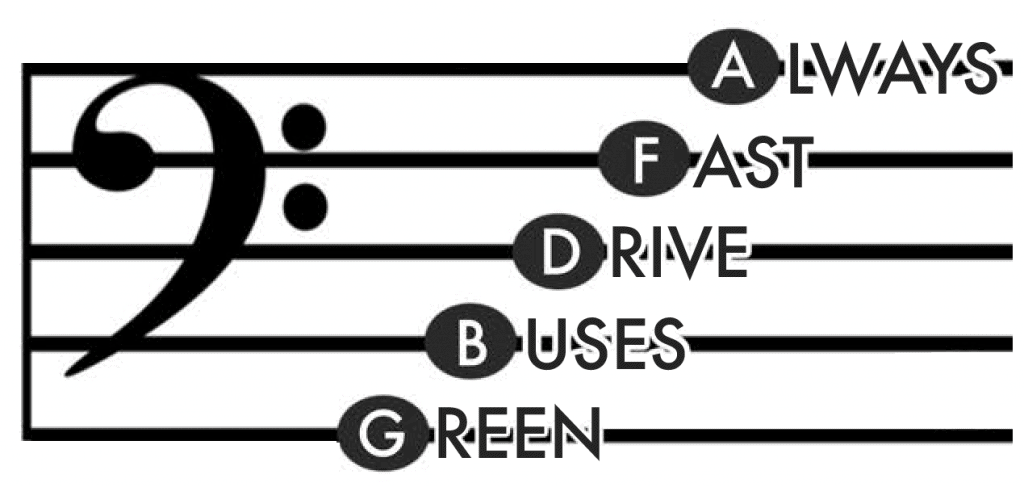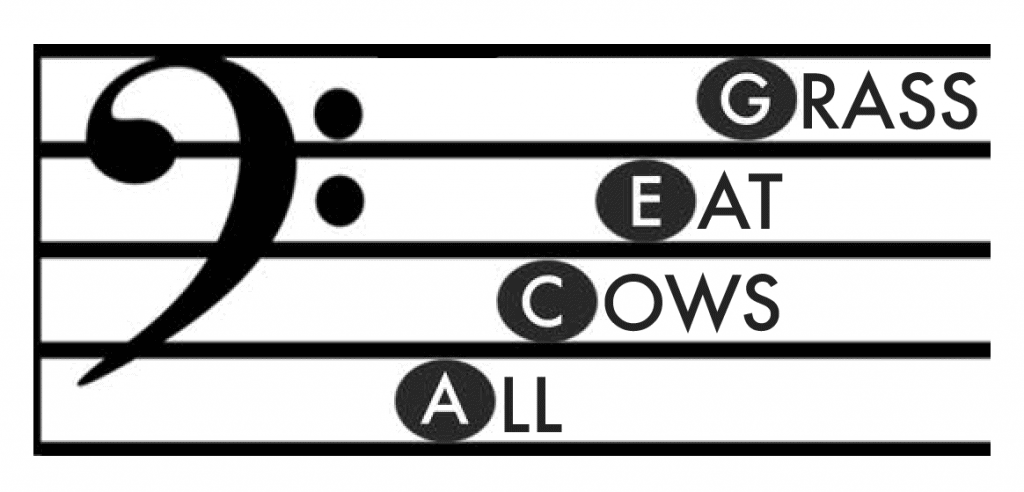Easy 5tone Scale for Each Instrument Bass and Treble Clef Notes
Have you ever looked at a piece of piano music and noticed that it is split into two parts? These two parts show the treble clef and bass clef . Together these clefs describe which notes to play in which hands.
Most beginners learn to read the treble clef first. This means that much less time is devoted to reading the bass clef. Even experienced pianists are often much slower at reading bass clef notes.
So if you feel like your left hand notes on piano are lagging behind, then don't worry. This post is going to teach you some tools that will help you to read bass clef.
Key takeaways
- The rhyme to remember lines and spaces is different than for the treble clef
- The bass clef allows us to play below middle C without ledger lines
- Bass clef will almost always be played by the left hand
- The bass clef is included in the grand staff, but can be written by itself
- We call the Bass Clef the F clef because it circles around the note F
Start your musical journey
- Fall in love with the music - Learn your favorite songs; whether they're classical, pop, jazz or film music, all at a level that suits you.
- Enjoy interactive piano lessons - Learn with courses that help you master everything from music theory, chords, technique and more.
- Get real-time feedback - Improve your practice with rich feedback as Skoove listens to your playing and highlights what went well and areas for improvement.

1 month free trial
No credit card details required
Start your piano journey now!
What is the bass clef?
The bass clef is a way to notate pitches below middle C. It is also commonly known as F clef because it locates F on the staff. Piano bass clef notes are most frequently played with the left hand.
Why do we need bass clef?
Bass clef is a useful tool for a few reasons.
- If we only used treble clef, we would have a more limited range of notes to read on one, five line staff. We would need to use an excessive amount of ledger lines and octave higher or lower markings.
- We can easily read pitches below middle C.
- By using both treble clef and bass clef, we can easily discern which parts of the music should be performed with the left hand and which parts should be played with the right hand.
- You can learn to read piano sheet music faster .
How to draw a bass clef
The bass clef is simple to draw. Begin by drawing a dot on the fourth line of the staff. This line marks F3 on the staff, the F below middle C. Next, draw a curve up to the right and then down and around to the left, like a backwards 'C'. Once you have this, draw two dots on either side of the fourth line, one in between the fourth and fifth lines and one in between the third and fourth lines.
What is the best way to learn bass clef?
The best way to learn bass clef piano notes is by practicing slowly and consistently. Just like learning to read treble clef, learning to read the bass clef notes on piano takes a bit of practice. However, there are a few helpful tricks that will help to increase your learning speed and ensure that the information sticks with you longer. We will practice with two methods here. The first is to memorize the notes by rhyming, mnemonic tricks like we commonly do with treble clef. The second is an interval method, where we base our reading off a few common interval spacings.

How to read bass clef piano notes
Learning how to read bass clef piano notes is an important skill. The bass clef stave system is made up of 5 horizontal lines. Just like notes for the right hand, bass clef piano notes can either sit on the line (line note), or in the spaces between two lines (space note).
If you look at the note chart below, you will see that middle C on piano is a line note. This is an important landmark to remember when learning how to read bass clef. The note 1 below middle C, which is B, is a space note. This pattern of line – space – line – space continues all the way down the bass clef.
Rhymes help you remember bass clef notes
Using the note chart to identify each bass clef note would be really slow and cumbersome. That's why it is common practice for beginners to learn two rhymes that can help them to quickly identify piano notes.
Here is the rhyme for all the line notes:

And the rhyme for all the space notes:

Try to memorize these two rhymes, or even make up your own!
Reading by intervals
When reading music, you could rely on the rhymes above to quickly identify notes. However, it would be a slow process.
Here is the solution: Most of the time you can actually just use something called "reading by intervals." Intervals describe the distance between two notes.
Now is the time to open the Skoove app and navigate to Beginner Course 2. Open the Lesson "Lean On Me & Left Hand" or alternatively look at this score:
Identify the first note by using the rhymes. In this example the first note is E. The E is a "space note."
The second note is a "line note" (F) and therefore directly neighbors the E. This simply translates to the next white key on your keyboard.
Other than to find the starting note, how many times are you going to use the rhymes in order to play this left hand part? That's right, none! Once you've got the starting note, the notes only ever move up and down by jumps of one. Simply transfer these jumps into single upward or downward steps with your fingers, and you'll easily be able to play the bass notes for a quick piano practice .
This next example is from the song "Only if" by Enya also from Beginner
Course 2.
Integrating what you've learned
There are two ways of reading piano bass clef notes: using the rhymes to identify each note and using the "reading by intervals" technique. Always use the rhymes to find the starting note on the piano keys . From then on, read the intervals (jumps) between notes and make the same jump on the piano keys using your fingers. Only revert back to using the rhymes if the jump between two notes is greater than 2.
Make sure you put this new approach into practice by taking your best posture and playing through all the songs in the Piano Beginner 1 course . Intermediates should check out all the great songs from the Intermediate song courses as well.
Author of this blog post

Eddie Bond is a multi-instrumentalist performer, composer, and music instructor currently based in Seattle, Washington USA. He has performed extensively in the US, Canada, Argentina, and China, released over 40 albums, and has over a decade experience working with music students of all ages and ability levels.
Source: https://www.skoove.com/blog/bass-clef-notes-on-piano/
0 Response to "Easy 5tone Scale for Each Instrument Bass and Treble Clef Notes"
Post a Comment